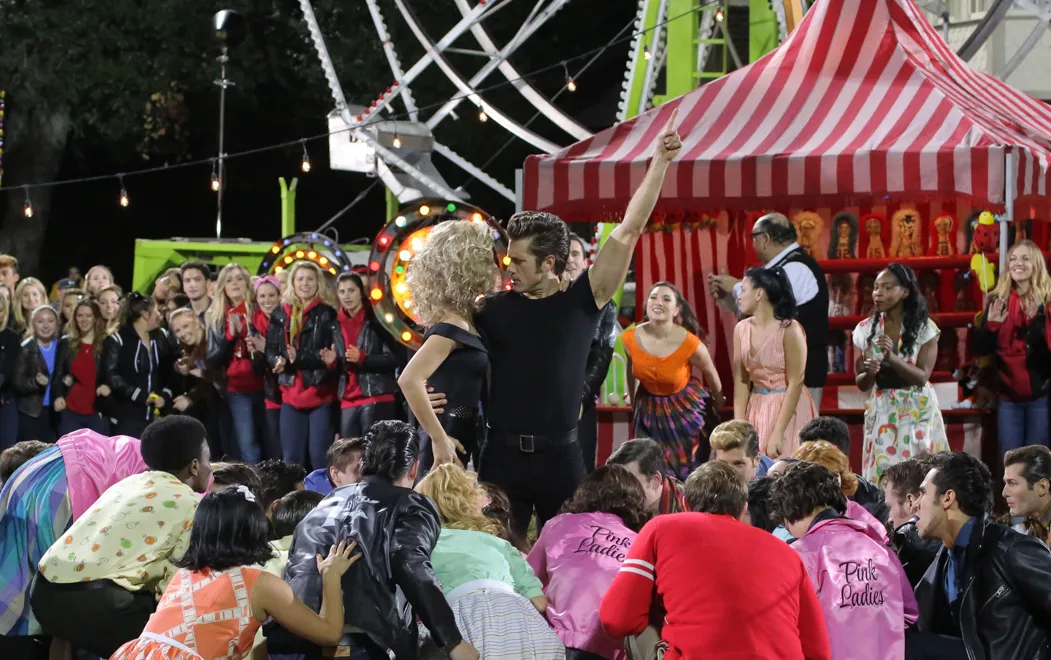A week after broadcast, television critic Bella Levaggi looks back on the groundbreaking “Grease: Live!”
While I’m still not entirely sure whether “Grease” was so named for the prevalence of cars, hair gel or skeevy men, but I’m far more certain that Fox’s television special “Grease: Live” manages to dazzle. A live, televised adaptation of the original musical, this newest rendition is at once freshly modern and comfortably familiar.
The performance, broadcast live from Warner Bros. Studios across two soundstages and the outdoor backlot, incorporates a live audience to mimic the immersive high energy of a traditional theater setting. While “Grease” as a film is often weighed down by dead moments, this live performance maintains the emotional momentum at all times. Sets revolve around each other and walls fall away and rush forward: The screen is a whirlwind of stage magic. As we watch cast members jump into golf carts to traverse the studio lot in time, the sense that this is an Experience™ intensifies.
As far as performances go, I would be remiss if I didn’t applaud Vanessa Hudgens and Keke Palmer for their outstanding work. Maybe it’s because I was never able to see Stockard Channing (Rizzo in the 1978 film adaptation) as anything other than Abbey Bartlet in “The West Wing,” but Hudgens’ take on the role is grittily humorous, sexy as all hell and tougher than nails. Similarly, Palmer as Marty Maraschino is both refreshing to look at (props to the color-blind casting) and to listen to.
Of course, stealing the show from Julianne Hough’s Sandy isn’t exactly a tall order. Whether it’s the character’s original writing or simply Hough’s Americana blandness, this iteration of Sandy would be completely forgettable if not for Hough’s dancing prowess.
Aaron Tveit, whose turn as Enjolras in the 2012 film version of “Les Miserables” was fraught with dark anger, here plays a relatively tame and boyish Danny Zuko. Tveit feels like a fragile puppy pretending to be a masculine greaser. It’s interesting to consider this in the context of the original’s obsession with male bravado, but, ultimately, Tveit succumbs to dynamism of his co-leads.
Regardless of the evident luster of this adaptation, the very story still fails in a lot of ways. It’s fun and upbeat, and I appreciate its supporting characters — whose depth I’m always surprised by — but it’s also overwhelmingly white, rigidly compulsory in its heterosexuality, uncomfortable in its toxic masculinity and unhealthy in its portrayal of Danny and Sandy’s relationship. These issues are intensely at odds with the strides that contemporary television and theater are making, and the contrast feels even starker when you consider director Thomas Kail’s body of work (namely “In the Heights” and “Hamilton”). So although the whole thing is gorgeous and absolutely impressive in design, there’s an underlying sense of disconnect between the dated source material and the innovations in staging and casting.
“Grease: Live” feels most polished when it extends an invitation to partake in the experience of spectacle. With cast members and creative names associated with mid-2000s family programming come associations with a time when networks brought their young viewers behind the scenes to understand how stories are made. I may never know why grease is significant to this musical, but I do know that, for two hours, I felt included in the making of a story that, though deeply problematic, is ultimately upbeat and enjoyable.
Contact Bella Levaggi at ilevaggi ‘at’ stanford.edu.
